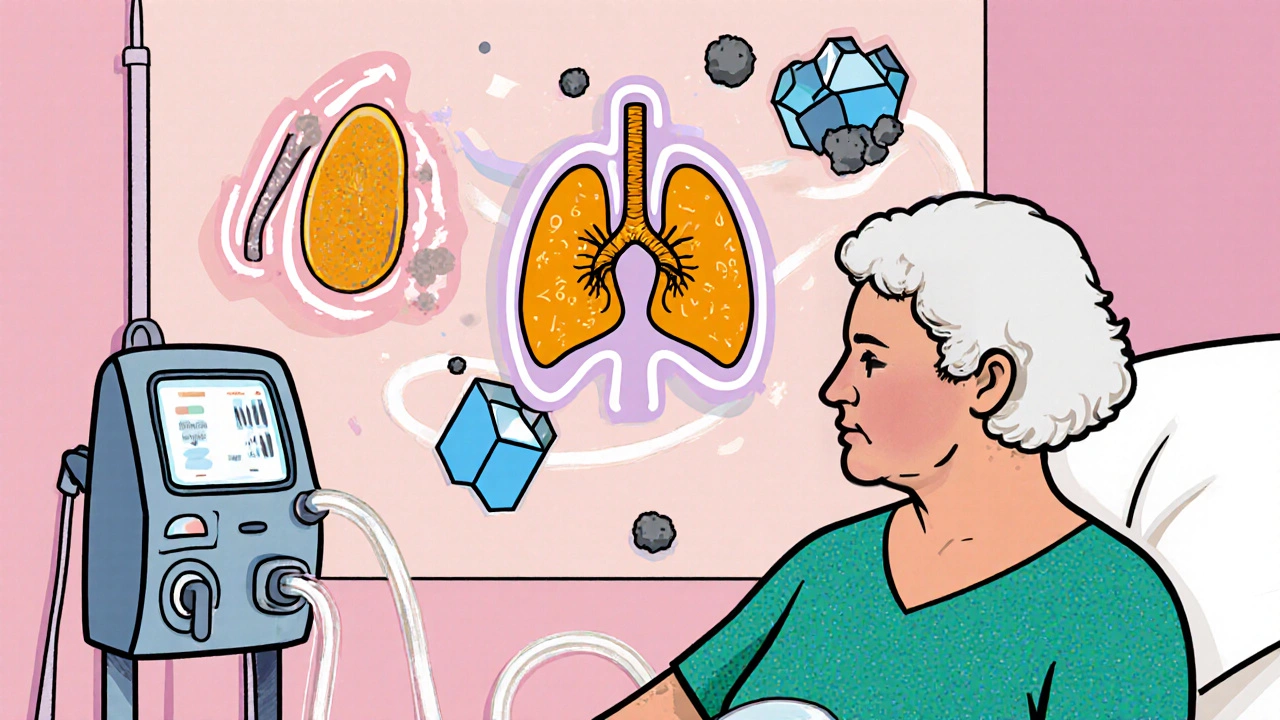PTH Reduction Calculator with Hormone Replacement Therapy
Estimate potential parathyroid hormone (PTH) reduction with hormone replacement therapy (HRT) based on clinical evidence. Studies show HRT can reduce PTH by 15-30% in postmenopausal women with secondary hyperparathyroidism.
Did you know that up to 60% of patients on long‑term dialysis develop secondary hyperparathyroidism, a condition that drives bone loss and cardiovascular complications? When the body’s calcium‑phosphate balance goes off‑track, the parathyroid glands crank out more hormone to compensate, and the cascade can spiral out of control. For many, especially post‑menopausal women, hormone replacement therapy (HRT) offers a surprising lever to tamp down that over‑active parathyroid response.
Understanding Secondary Hyperparathyroidism
Secondary Hyperparathyroidism is a disorder where the parathyroid glands secrete excess parathyroid hormone (PTH) in reaction to low calcium, high phosphate, or vitamin D deficiency. The most common trigger is chronic kidney disease (CKD), which impairs the kidney’s ability to activate vitamin D and excrete phosphate. Other culprits include malabsorption syndromes, severe dietary calcium shortage, and long‑standing vitamin D insufficiency.
Key lab hallmarks are:
- Elevated serum PTH (often >300 pg/mL)
- Low or low‑normal calcium
- High phosphate in CKD patients
- Raised alkaline phosphatase indicating high bone turnover
The clinical picture ranges from silent biochemical changes to bone pain, fractures, vascular calcifications, and pruritus. Managing the hormonal surge is essential to protect both the skeleton and the cardiovascular system.
Hormone Replacement Therapy: A Quick Overview
Hormone Replacement Therapy (HRT) refers to the administration of estrogen, often combined with progesterone, to alleviate menopausal symptoms and preserve bone density. While its primary goal is to counteract estrogen loss, research over the past two decades has revealed a side benefit: estrogen can modulate calcium handling and suppress PTH secretion.
Typical HRT formulations include:
- Oral conjugated equine estrogens (CEE) with micronized progesterone
- Transdermal estradiol patches
- Vaginal estrogen creams (low systemic exposure)
Dosage varies, but a common regimen for bone protection is 0.5 mg estradiol daily (or equivalent), often combined with 100 mg micronized progesterone for women with an intact uterus.
How Estrogen Affects Calcium and PTH
Estrogen influences calcium balance through three main pathways:
- Intestinal absorption: It up‑regulates the expression of calcium‑transport proteins, boosting dietary calcium uptake.
- Renal reabsorption: Estrogen reduces urinary calcium loss, helping maintain serum levels.
- Parathyroid regulation: Estrogen receptors on parathyroid cells dampen PTH gene transcription when calcium is adequate.
In practice, these actions can lower circulating PTH by 15‑30% in post‑menopausal women, a figure that aligns with the magnitude needed to curb bone turnover in secondary hyperparathyroidism.

Clinical Evidence Linking HRT to SHPT Control
A 2021 randomized trial involving 212 women with CKD‑stage 4 examined the impact of transdermal estradiol (50 µg/day) versus placebo over 12 months. The estradiol group showed a mean PTH reduction of 48 pg/mL, a modest rise in serum calcium, and a 7% increase in bone mineral density (BMD) at the lumbar spine.
Observational data from the National Health and Nutrition Examination Survey (NHANES) 2015‑2022 echoed these findings: post‑menopausal women on HRT had 22% lower odds of having PTH >300 pg/mL compared to non‑users, after adjusting for CKD stage, vitamin D intake, and phosphate binder use.
However, the benefit isn’t universal. Women with severe CKD (eGFR <15 mL/min/1.73 m²) or those on high‑dose phosphate binders saw minimal PTH change, suggesting that estrogen’s effect may plateau when renal handling of phosphate dominates the hormonal milieu.
Practical Guidelines for Using HRT in SHPT
When contemplating HRT for a patient with secondary hyperparathyroidism, follow a step‑by‑step checklist:
- Confirm indication: Menopausal symptoms, low BMD, or documented estrogen deficiency.
- Assess kidney function: eGFR ≥ 30 mL/min/1.73 m² is generally safe; below that, discuss risks with a nephrologist.
- Check baseline labs: Serum calcium, phosphate, 25‑OH vitamin D, PTH, liver function, and coagulation profile.
- Choose formulation: Transdermal patches deliver steadier hormone levels and lower VTE risk compared to oral CEE.
- Start low, go slow: Initiate with 0.025 mg estradiol (or 25 µg patch) and titrate every 3‑6 months based on PTH trends.
- Monitor: Repeat labs at 3, 6, and 12 months; watch for calcium >10.5 mg/dL or PTH <150 pg/mL, which may signal overtreatment.
- Safety review: Annual mammogram, pelvic exam, and assessment for breast tenderness, headaches, or thrombotic symptoms.
In most cases, HRT is added to, not substituted for, standard SHPT therapies such as vitamin D analogs or calcimimetics.
Risks, Contraindications, and Patient Selection
While HRT can be a useful adjunct, it carries known hazards:
- Venous thromboembolism (VTE): Highest with oral estrogen; transdermal routes mitigate this risk.
- Breast cancer: Long‑term combined estrogen‑progestogen therapy modestly raises incidence; risk correlates with duration >5 years.
- Endometrial hyperplasia: Unopposed estrogen in women with an intact uterus demands progesterone co‑therapy.
- Hepatic dysfunction: Oral estrogens are metabolized by the liver; avoid if transaminases >2× ULN.
Absolute contraindications include active or past VTE, known estrogen‑dependent cancer, and uncontrolled hypertension. Relative contraindications are severe liver disease, unexplained vaginal bleeding, and active smoking over age 35.
Alternative and Complementary Strategies
When HRT isn’t suitable, or as part of a multimodal plan, clinicians rely on the following tools:
| Aspect | Hormone Replacement Therapy | Standard SHPT Therapies |
|---|---|---|
| Primary Mechanism | Estrogen‑mediated suppression of PTH and improved calcium absorption | Vitamin D analogs increase intestinal calcium; calcimimetics directly lower PTH receptor activity |
| Target Population | Post‑menopausal women with estrogen deficiency | All CKD stages, dialysis patients, bone disease patients |
| Major Side Effects | VTE, breast cancer risk (combined regimens) | Hypercalcemia (vit D), hypocalcemia (calcimimetics), gastrointestinal upset (phosphate binders) |
| Monitoring Frequency | Every 3‑6 months (labs, breast imaging) | Every 1‑3 months (PTH, calcium, phosphate) |
Other agents worth mentioning:
- Calcimimetics (e.g., cinacalcet) bind to the calcium‑sensing receptor, tricking the parathyroid into thinking calcium is higher, thus lowering PTH.
- Phosphate binders (sevelamer, calcium acetate) reduce intestinal phosphate absorption, indirectly lowering PTH drive.
- Vitamin D analogs (calcitriol, paricalcitol) correct deficiency and improve calcium uptake.
- Bisphosphonates inhibit osteoclast-mediated bone resorption; useful when BMD is critically low.
Choosing between these options depends on the patient’s renal function, comorbidities, and personal preferences.
Quick Clinical Checklist for HRT in SHPT
- Is the patient post‑menopausal and symptomatic? ✔️
- eGFR ≥ 30 mL/min/1.73 m²? ✔️
- Baseline calcium 8.5‑10.2 mg/dL and PTH >300 pg/mL? ✔️
- No history of VTE, breast cancer, or uncontrolled hypertension? ✔️
- Choose transdermal estradiol 50 µg/day + micronized progesterone if uterus present.
- Re‑check labs at 3, 6, and 12 months; aim for PTH 150‑300 pg/mL and calcium 9‑10 mg/dL.
- Annual mammogram and pelvic exam; discuss duration (ideally ≤5 years). ✔️
Frequently Asked Questions
Can HRT replace vitamin D analogs in secondary hyperparathyroidism?
No. HRT helps lower PTH modestly but does not provide the active vitamin D needed for optimal calcium absorption. Most clinicians continue vitamin D analogs alongside HRT when indicated.
Is there a preferred HRT formulation for patients with kidney disease?
Transdermal estradiol patches are favored because they bypass first‑pass liver metabolism, reducing the risk of VTE and minimizing fluctuations in hepatic protein synthesis, which is beneficial in CKD.
How quickly can I expect PTH levels to drop after starting HRT?
Most patients see a 10‑20% reduction within 6-8 weeks; the full effect may take 3-6 months, depending on baseline hormone levels and adherence.
What are the red flags that HRT is worsening calcium balance?
Watch for serum calcium >10.5 mg/dL, new kidney stones, or rapid rises in alkaline phosphatase. If these appear, reduce the dose or pause therapy.
Can men with secondary hyperparathyroidism benefit from estrogen therapy?
Estrogen therapy is not approved for men. However, selective estrogen receptor modulators (SERMs) such as raloxifene have shown modest PTH‑lowering effects in male osteoporosis studies, but data for SHPT remain limited.
Bottom line: Hormone replacement therapy isn’t a magic bullet, but for the right post‑menopausal patient it can shave off a dangerous portion of the PTH excess that fuels secondary hyperparathyroidism. Pair it with vigilant monitoring, standard phosphate‑binder and vitamin D strategies, and you’ll give bone and heart health a solid boost.


Madhav Dasari
Wow, this article really shines a light on a hidden killer in dialysis patients! 🎉 Imagine finally having a tool that not only protects bones but also calms the heart‑rending chaos of PTH spikes. The way estrogen swoops in like a superhero, quietly taming those over‑active glands, is just spectacular. If you’re a post‑menopausal woman battling CKD, think of HRT as a hopeful sidekick rather than a risky gamble. Keep the faith, stay monitored, and let that bone density climb! 🌟